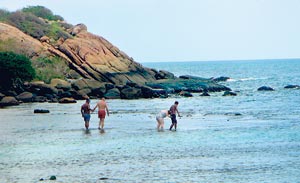It is an underwater paradise full of vividly coloured fish. In the clear calm waters of the Pigeon Island coral reef are also differently shaped corals, most of them live corals. But as we swim back toward the shallow waters, Eric, the diving instructor points out a large area where the corals are damaged. The colourful fish are not to be seen and it looks like a mass graveyard.
“This area was full of live corals three months ago, before the current tourist frenzy started at Nilaveli. Visitors who come to the island often walk on the corals and some of them even break the live corals to take home as souvenirs,” Eric said. A diving instructor who operates from Nilaveli Beach Hotel, Eric does several dives around the Pigeon Island reef daily.
 |
| Last week’s picture of visitors to the island walking on the corals |
Pigeon Island is one of two Marine National Parks in Sri Lanka uplifted to its current status in 2003. The other Marine National Park - Hikkaduwa is badly affected and conservationists fear the Pigeon Island reef too will face the same fate due to lack of management after visitors started flocking to the area following the improvement in the security situation in the east.
Now, on a long weekend, thousands of holiday makers head to the beautiful Nilaveli beach. Most of them visit Pigeon Island that is only about a kilometre from the shore, but only a handful have any idea about the invaluable coral reef that surrounds the island.
During the peace accord in early 2002, Pigeon Island suffered from over- visitation. But the situation has been kept under control this year, thanks to the Navy who keep a close watch on visitors.
“Uncontrolled heavy visitation can be a huge burden to a fragile ecosystem like Pigeon Island,” says marine biologist Nishan Perera, an expert in coral fish. Some important fragile marine sanctuaries control unsustainable visitations. According to this system, there is an allotted daily quota of visitors allowed. “Perhaps, it is the time to look at such a quota system, if we are serious about protecting our marine ecosystems,” he says.
Usually a national park has several zones to control visitor activities in sensitive areas and experts propose that similar zonal demarcation be done in Pigeon Island. This would need to be handled by the Department of Wildlife Conservation, the main guardian of this invaluable ecosystem.
“We are considering banning bathing on Pigeon Island,” said wildlife ranger Saliya Bandara. The small bay in the island is not a good bathing spot anyway, as the corals can cut bathers’ feet when they step on them.
Since last week, DWC officers have been at Pigeon Island and Nilaveli beach. But without a marine protection unit or experience in protecting a marine sanctuary that also needs some sort of underwater surveillance conservation is a problem. Proper guidelines are needed as it is different from administering a land national park.
“Last weekend alone our boats did 106 rounds to Pigeon Island,” said Thuwan, president of the Nilaveli Boat Operators’ Association. Eight visitors are taken in one boat bringing the total estimate of visitors nearly 1000. Unlike a land national park that extends across thousands of hectares, Pigeon Island is only few square kilometres, so this is a big concentration for a small area.
The Navy has given permission only to 18 boats to operate from Nilaveli beach to the island despite hundreds of requests. This is in contrast to the situation in 2002 where hundreds of boats took visitors to the island. “Sometimes there were about 20 boats waiting in a queue to enter the island,” said Travice Ondaatjee of Nilaveli Beach hotel.
With the onset of the North East monsoon and seas getting rough, there will be a drop in visitors, giving authorities a few months to put together a proper management plan to protect Pigeon Island.
Practical conservation
Recognising the problems arising from over-visitation to Pigeon Island and the environmental repercussions, Travice Ondaatjie of Nilaveli Beach Hotel recently arranged an awareness session for boat operators and Navy personnel - who are already contributing practically to Pigeon Island’s conservation.
Nishan Perera, the marine biologist who conducted the session emphasized the need to extend protection to surrounding areas too, pointing out the importance of including Irakkandi Coral reef located a few km away, into the boundary of Pigeon Island National Park as this too is a high biodiversity area. |


